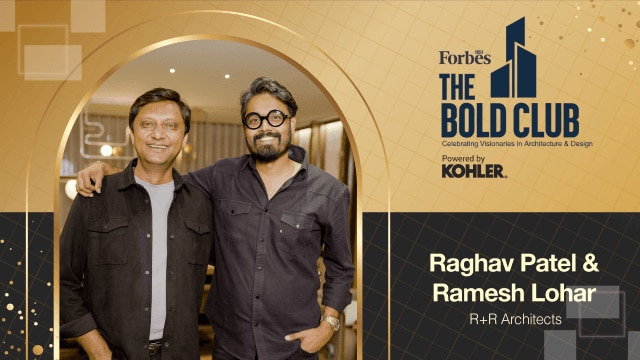
Raghav Patel: Founder-Partner, Principal Architect, Ramesh Lohar: Founder-Partner, Interior Designer – R+R Architects
Ramesh Patel and Ramesh Lohar founded R+R Architects in 2016 on the four principles of creativity, customer-centricity, contextual design, and collaboration. Together, they have led the firm to create great spaces and win numerous awards for their exceptional designs. At R+R, design is an organic process – akin to breathing, it should come automatically and effortlessly. Emphasis is on efficiency, honest expression of materials, and technological advancements. For them every design decision is intentional, ensuring that technology serves the space, like using features like smart lighting and adaptive climate control to build for the future. Patel and Lohar consider AI (Artificial Intelligence) as a transformative tool for architecture, making designs more efficient, creative, and sustainable. At R+R, AI is a natural extension of their vision to value efficiency, logic, and honest expressions of materials and explore innovative ideas while staying true to timeless, user-centric designs. With AI, biometrics, and kinetic structures evolving, young architects and designers should master the fundamentals before innovation to design not just buildings but living, breathing systems.
Raghav Patel and Ramesh Lohar founded R+R Architects in 2016 on the four principles of creativity, customer-centricity, contextual design, and collaboration. Together, they have led the firm to create great spaces and win numerous awards for their exceptional designs.
For both Patel and Lohar, architecture was not just a career choice but a natural calling. Patel recalls his childhood inclination towards the field of art and making models from his notebook hardcovers. It was a natural progression for him to build design and pursue architecture as a career. Lohar attributes his passion to his lineage. Growing up watching his father on the drafting board inspired him to the field of design and follow the path of interior design.
At R+R, design is an organic process – akin to breathing, it should come automatically and effortlessly. Emphasis is on efficiency, honest expression of materials, and technological advancements. For them every design decision is intentional, ensuring that technology serves the space, like using features such as smart lighting and adaptive climate control.
Among the many distinguished projects, Patel’s favourite is ‘The Russet Abode’, which blends modernism and brutalism. Inspired by the ‘Delo’ concept, the entryway draws from traditional elements. The house has a climate-responsive C-shaped layout, with a central courtyard facing north that optimizes sunlight and ventilation, with the southwest face blocked and the northeast open. Materials like concrete, exposed brick, and warm wood interiors are used to create a harmonious balance. With full-length windows and a grand double-height verandah, the design seamlessly connects indoor and outdoor spaces.
For Lohar, ‘Zaura’, a luxury jewelry boutique exemplifies his vision of blending naturalism with modernism. The boutique redefines luxury retail by creating a space that feels like a museum of jewelry, the design being inspired by raw stone caves. Every design element is custom-made to enhance its aesthetics. Strategic lighting accentuates the jewelry while maintaining a warm and inviting ambiance.
Patel and Lohar consider AI (Artificial Intelligence) as a transformative tool for architecture, making designs more efficient, creative, and sustainable. At R+R, AI is a natural extension of their vision, to value efficiency, logic, and honest expressions of materials and explore innovative ideas while staying true to timeless, user-centric designs. AI helps streamline workflows, automate repetitive tasks, and analyze vast data sets allowing architects to focus on creativity and strategy. AI enhances human intuition by helping to design spaces that resonate with people and evolve with their needs.
The co-founders envision the future of architecture in adaptive spaces that evolve with people, climate, and technology. With AI, biometrics, and kinetic structures evolving, young architects and designers should master the fundamentals before innovation to design not just buildings but living, breathing systems.